


VOL. II NO. 52 REG NO. L5015 DELHI, THURSDAY SEPTEMBER 7, 1944.
|
LIFE OF ATC PILOT
ATC BASE, ASSAM - Knocked unconscious in a plane jump before he had a chance to pull his parachute ripcord, Lt. Kenneth P. Stoeckmann is able to tell about his close brush with death today because of one of those strange freaks of Fate.
Stoeckmann was flying a four-engined transport which was forced out of control by a structural failure, which sent the ship into a spin from which the pilot found it impossible to pull out. He gave the crew the order to jump.
As he left the spinning plane, Stoeckmann was knocked unconscious. But when he hit the tail of the ship, a miracle happened - the jolt opened his parachute.
Three panels of Stoeckmann's 'chute was ripped in the process, however. His descent was rapid, estimated at 50 miles per hour. Again Fate was on his side. He landed on the steep slope of a mountain and rolled several hundred feet before he could stop himself. At first he was unable to move, but he had broken no bones and shortly recovered sufficient strength to begin a seven hour trek down a mountain pass, where he was picked up by Chinese soldiers who carried him to a Chinese radio station.
Sent to seek other members of the crew, the soldiers found Sgt. Russell G. Kennedy, the crew chief, who landed 10 miles away. The two men were given medical attention and returned to their home base. The body of the co-pilot was found in the wreckage of the plane, where he had become entangled in his 'chute and safety belt harness and was unable to get out of his seat. The radio operator also lost his life in the crash.
GENERAL KILLS TWO JAPANESE
Major generals aren't in the habit of personally slugging it out with the enemy. But then, Maj. Gen. F. W. Festing, who killed two Japs as his 36th British Division moved down the Mogaung-Mandalay Railroad, likes action. What's more, he has seen his share of it.
Festing, now serving under Gen. Joseph W. Stilwell in the North Burma campaign, participated in the tragic Battle of France, took part in the Norway campaign and commanded the assault landings at Madagascar, where he won the DSO for the capture of Diego Suarez.
One of the two Japs whom Festing killed in North Burma was an officer, whose sword he now greatly prizes.
Festing's name as commander of the 36th Division, first all-British unit to serve under Stilwell, was recently announced when his unit captured Pinbaw. Today, the 36th is hammering its way toward Hopin, where a road block was held for a time by an LRP group.
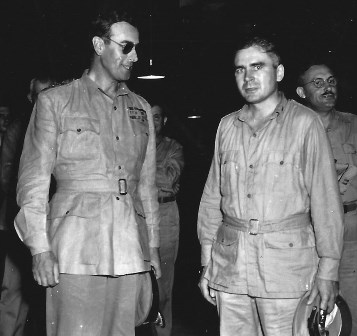
|
American Doctor Saved Supremo's Eyesight
KANDY, CEYLON - (UP) - A young American doctor's skill is credited by Lord Louis Mountbatten with saving the sight of his left eye when the Supreme Commander was injured on the North Burma front in early March.
Mountbatten was personally driving a jeep along the jungle trail, inspecting Jap defenses and viewing abundant Jap dead in the vicinity of Maingkwan in the Hukawng Valley when a low hanging section of a dead bamboo struck him, piercing his left eyeball.
The King's cousin was evacuated by plane to an American hospital in the Indian province of Assam, where he lay on his back for five days with his eyes bandaged. The blow from the sharp bamboo caused a hemorrhage and, though an operation was unnecessary, the injury required delicate treatment.
Mountbatten was treated by Maj. (then Capt.) Harold G. Scheie, who is a native of Minnesota and graduate of the University of Pennsylvania Medical School. Following graduation, Scheie was a member of a hospital staff and was inducted into the Army with a Pennsylvania Hospital unit which two years ago arrived in Assam to set up the largest hospital in the CBI Theater.
Mountbatten corresponds regularly with Scheie and unfailingly visits the Pennsylvania unit when in Assam. - By Frank Hewlett, United Press correspondent.

|
UNCLE JOE CHIDES HQ BRASS
Gen. Joseph W. Stilwell, CBI Commander, etc., was a visitor, so the two officers who daily report the fluctuations of war to the New Delhi HQ staff were on their mettle.
Following the sweep of their pointers on the large wall maps, Uncle Joe fired frequent questions. The two officers answered with staccato snap.
Then it was all over, and the two officers stepped back with an inward glow of satisfaction.
The general's eyes twinkled as he prepared to leave the room. "A very fine summary," he commented, "but I'm happy that my Chinese friends weren't here to hear you pronounce the names of their towns."
Jap Suicides In Tengchung
Y-FORCE HQS., CHINA - Fierce fighting continues on the Salween River Front, reports Brig. Gen. Frank Dorn's U.S. liaison group with the Chinese 20th, 11th and Eighth Route Armies, with the surrounded Jap garrison
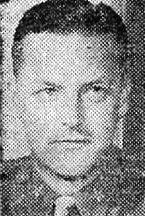
|
The left flank of the 20th Army has crossed and cleared the street connecting the center of Tengchung with the Northwest Gate of the old city wall, which has been reoccupied by the Chinese.
The Chinese right flank is held up by strong Nip defense boxes in the temple areas in the southern part of the city, although the pillboxes were being destroyed one by one. The enemy is being compressed into a small defensive perimeter, continually pounded by artillery and mortar fire.
The Chinese have discovered first cases of Japanese suicides in Tengchung with occupation of the pill boxes inside the city. One Nip had shot himself, another had hanged himself.
At Sungshan, the Nips still hold positions on the heights dominating the Burma Road. Chinese troops of the Eighth Army are continuing their attacks, with several more fortified positions having fallen.
At Lungling, the 11th Army made local gains. Three miles southwest along the Burma Road at Nantienmen, a Jap relieving force for their besieged Lungling garrison was held up by a force of 31 Chinese who died to the last man before Chinese reinforcements could come up and occupy high ground dominating the road.
Y-Force reports say that the Chinese claim the Japs are using transport and quartermaster troops to bolster their Salween garrisons and that enemy casualties have been found with bandages on, indicating a crisis in Jap manpower.
|
TOWARD HOPIN
Units of the 36th British Division of Maj. Gen. F. W. Festing are advancing along the Mogaung-Mandalay Railroad from Pinbaw towards Hopin this week and it is announced that Allied forces now hold control of 20,000 square miles in Burma, one tenth of the total area of the country.
Elements of the 14th Army have cleared 100 miles of the road south of Imphal and are driving towards Tiddim, while other units have crossed the Chindwin River and cleared the west bank north of Tonnhe of enemy opposition.
Chinese units around Kazu reported only patrol activity.
LAUDED BY STILWELL
The advance of the 36th towards Mandalay is a slow, tortuous business. Fighting in mud and water, sometimes four feet deep, the rugged British troops of Festing are making good progress, however, and are more than half-way to Hopin. Festing received a congratulatory note from his commanding officer, Gen. Joseph W. Stilwell, on his workmanlike job in taking Pinbaw last week.
The 36th, first all-British unit to operate under the Stilwell command, is a veteran outfit, having served in the Arakan campaign and at Madagascar when the Allies took over this French possession in 1942.
TWO-WAY DRIVE
On the evening of Aug. 27, Scottish and Welsh units made a two-way drive that took Pinbaw. In the first three weeks the 36th was in the field in North Burma, they advanced 29 miles along the Mogaung-Mandalay road.
The elements are still proving a stubborn foe. Heat, watery trails and muddy terrain are slowing up the advance, with isolated Jap machine gunners and snipers attempting to fight delaying actions.
XMAS 92 SHOPPING DAZE AWAY
Out in CBI the frost isn't even on the mango yet, but here we are thinking about Christmas, though the happy holiday is still 92 shopping days distant.
The Office of War Information this week reminded Stateside folk that overseas gifts should be sent between Sept. 15 and Oct. 15, marked "Christmas parcel," and be wrapped properly.
OWI also published a roundup of what service men and women would like to find in their Christmas morning stocking.
Soldiers, it was said, would like money orders and wallets, pipes and tobacco, cigarettes, soap, hard candy and reading matter. Automatic pencils, stationery and wrist watches were also quoted.
Sailors, evidently with lots of idle shipboard time on their hands, hope for books, playing cards and poker chips. Pocket-sized dictionaries, novels, mysteries, Westerns and humor - but not war stories - comprise their favored reading list. Shower slippers and moccasin type bedroom slippers, pocket knives and fountain pens, and "canned luxury foods like olives" are welcome, says OWI.
Army and Navy nurses and WACs, said the report, are interested in getting little feminine articles like bobby pins, hairnets and cosmetics, lingerie, scented soaps and boudoir slippers. Reading matter and canned delicacies, candy and cakes, also made the gals' lists. The WACs, it was said, want sheer stockings first of all, also zippers and elastic girdles.
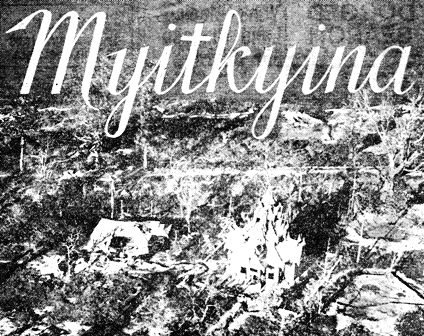
And One Wonders Whether by Design or Whether Fate Played a Hand |
By CAPT. FLOYD WALTER
Roundup Editor
MYITKYINA - Through a narrow pass slashed deeply into the heart of the 8,000-foot razor-back ridge, the Combat Cargo Command C-47 strained eastward from its base in Assam and now blonde, loose-limbed Capt. J. S. Craik turned around from the pilot's seat and shouted above the drone of the twin engines:
"We're almost there."
Minutes later, we swept down into a broad valley where serpentining through a carpet of green, I followed the course of the Irrawaddy with quickening interest. Soon the lazy horseshoe curve of the river against which Myitkyina snuggles was focused into view, and then the brown gash in the valley's verdant floor marking the airstrip Merrill's Marauders and the Chinese seized when they stormed out of the hills, May 17.
And, finally, we were over the field, busy below with activity, and then, swinging east, over the town itself, pockmarked with huge, water-filled craters and cluttered with the rubble of houses.
Not long after, I stood on the edge of the field. Engineers had already swarmed upon Craik's C-47, unloading the precious cargo it had transported from India. Everywhere, there was movement. 'Cats clanked noisily about their business. Bulldozers stubbornly waged battle against the earth. C-46's and C-47's landed with incredible regularity, fattening the already comfortable stockpiles of equipment and supplies. Fighter planes, based on the field, roared overhead in beautiful, reassuring pattern. Saucy L-5's flitted about on mysterious missions. Trucks and jeeps jounced into the area from the east, and, trailing clouds of dust, disappeared toward town with full loads.
People meant business here. The feeling hit you with full impact. This airfield, you thought, is one of the keys to Uncle Joe Stilwell's unlocking the door to the south and east; and now that it is ours no time is being lost capitalizing upon it. Skeletons of wrecked aircraft littering the sides of the runway paid silent witness to part of the price we had been willing to pay.
I flagged a passing jeep and introduced myself to the driver, Pvt. Charles Baylis, of Plainfield, N.J. He was dressed in green fatigues and wore his cap perched rakishly over his left eye in Dead End Kid fashion. This was the start of a beautiful friendship. The irrepressible young man had been Brig. Gen. Theodore F. Wessel's driver during the heat of the scrap for Myitkyina and knew the points of interest in the town as well as the conductor of a New York rubberneck tour knows his itinerary.
Jouncing toward headquarters through the outskirts of town, I began to see a few of the scars of battle at close hand - houses rent with gaping holes where bombs and artillery and mortar shells had found their mark, networks
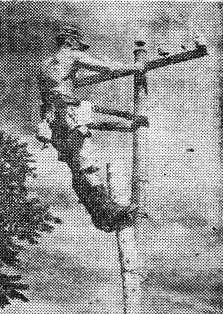
Strings Wire |
We reached headquarters, situated in a row of houses not mortally hit and showing evidence of recent repair. The two-story wooden structure in front of which the jeep stopped was the stomping ground of Col. John P. Willey, senior American officer in the town. I clambered up the wooden stairs to report. The colonel wasn't there at the moment, but busy, sandy-haired Capt. Charles Burr, the assistant G-1, checked me in and invited me to wait.
It was as hot as the hinges of Hell. Someone later declared the thermometer at the airstrip registered 140 degrees. No one argued the point. Perspiration flowed from every pore, soaked pants and shirts through and generously beaded foreheads.
Despite the intense heat, accented by the high humidity, there was activity outside the colonel's house. Stripped to the waist, sun-bronzed Signal Corps workers assiduously strung wire, scaling trees and climbing into shattered houses. A group of naked G.I.'s gathered around a well and sloshed water over one another from a crude wooden bucket. An M.P. scooted along the dirt road on a motorcycle, and soon after a 6x6 and a rickety captured Jap truck rumbled by.
From my vantage point, I watched a polyglot group of workers - Burmese from several regions, Gurkhas, Indians and Chinese - clear away the rubble from around the headquarters buildings, prodded good-naturedly by a lieutenant in green fatigues. The incongruity of their attire was something out of a comic magazine. There was a husky Kachin proudly wearing British boots, American helmet, Japanese shirt and a checkered skirt of a pattern you've seen on tablecloths in roadside restaurants along U.S. Highway 99. The others were attired as strangely, with gear gathered off the stage of conflict after the Japanese had been driven across the Irrawaddy.
Col. Willey did not turn up until after lunch. Tall, soldier-straight, with a mop of black hair, he seemed to fill the small upstairs room. On one corner, a tiny bird, robbed of squatter's rights, continued nervously to build its nest, and through an open window wafted an incredibly beautiful velvet butterfly. The colonel puffed on a cigar and suggested the best way to get a story would be to take his jeep and tour the town.
Downstairs, Baylis greeted me and, in the grand manner, ushered me into his quarter-ton. Just as we were about to pull out, a 1920 Model T Ford coupe chugged up to headquarters, and a G.I. with reddish hair and scraggly mustache bounced out and clattered upstairs with a message for the colonel. The Japs must have left this ancient vehicle behind without fear of its being put to use. It was rusty, quaking and a cork did service as a radiator cap, but the ingenuity of the Ordnance Section had made it operate and it was being put to good use. Another mode of captured transportation pressed into duty were Japanese bicycles, and not an hour passed that somewhere you didn't see Lt. James Chan, a U.S.-born Chinese, peddling furiously to heaven knows where. There were American bikes, too, and one of the most side-splitting sights you ever saw in your life would be challenged by that of a Chinese soldier trying to ride one. He weaved all over the road at the peril of everyone's life and limb, including his own, but danger didn't erase the grin from his face nor stem the stream of delighted ding how's.
Myitkyina, before the Jap conquest of Burma, was a lovely resort town of 20,000 inhabitants, slumbering peacefully through the seasons. The red flood of war boiled through Myitkyina less than three weeks before this article was written and had surged 20 miles southward down the road to Bhamo. It left behind an incredible vista of destruction. The severity of damage increased as we neared the river. At first, I marveled at jagged holes in roof tops, shattered walls and direct bomb, artillery and mortar hits on entrenchments. Then we reached the main part of town, where the full fury of attack had been felt, and there were often no houses remaining upon their foundations at all, but merely a rubble of corrugated tin roofing and splintered lumber. The few pieces of furniture which remained intact throughout the terrible onslaught had long since been taken by Chinese troops moving through town, and, as for souvenirs, the area had already been picked bone clean by Americans, Chinese and British, as well as some of Myitkyina's inhabitants who had drifted back.
Suddenly, we jerked to a stop long enough for Baylis to point out a pagoda of exquisite design,
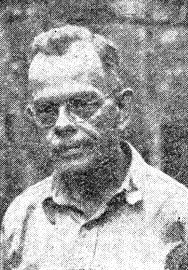
Three Grueling Months |
Now we reached Lt. Col. Gordon S. (Burma Surgeon) Seagrave's unique hospital. The patients rested on cots either under long, low thatched shelters or in a series of various-shaped tents. The doctor's office was situated in a house less battered than those about it. I asked a slim, pretty Burmese nurse whether Seagrave was in, and she blushed, tittered, covered her face with her hands and ran upstairs. It was rather disconcerting.
It didn't take long to find Seagrave, whose greeting was courteous but who was locked in earnest conversation with Lt. Col. W. W. Hiehle, Surgeon of the Myitkyina Task Force. The Burma Surgeon's forehead was wrinkled and he wore the appearance of a man who has spent long hours under exacting conditions and, now that he can finally rest, suddenly realizes how desperately tired he is. The doctor spent close to three grueling months at the airstrip before, 10 days ago, he moved his hospital into town. My chauffeur and his itinerant reported were soon on their way again.
Past more wrecked houses we bumped. A six-foot-long snake wriggled into the ruins at our approach. Two G.I.'s photographed a rusted artillery piece whose barrel was blown up by the Japanese as they retreated into the vitals of the town. Down almost every street we drove, lines of Chinese troops trudged wearily, perspiring profusely, some carrying weapons and other articles with which to set up light housekeeping.
Then we reached one of the few brick buildings in town, chipped by shellfire, but serviceable, and pressed into duty as Myitkyina's APO. During the morning, a group of Chinese cleaning up the debris in front of the post office lifted up some boards and choked at the putrefying smell of five dead Japs hastily buried beneath them. Dead Japs are still being found in town and an occasional one of the live variety, too, nearly always on the verge of starvation but not always willing to give himself up without a final shot. It may be some days before the last of the cunning concealments of the Nipponese are discovered.
Chinese bivouac areas were spread from hell to breakfast. Some of the soldiers sprawled under thatched roofs without sides, others lived in tents, and then there were the plutocrats who had moved into what was left of houses, cannibalizing adjacent structures that were harder hit to make themselves comfortable. You began to notice that the house-dwelling Chinese always gathered on the top floor and made a mental note of the idiosyncrasy. Everywhere you looked, there were lines of clothes, freshly washed.
Earlier, at headquarters, the beauties of the fabulous teakwood forest on the southern fringe of the town had been described to you. Now Baylis tooled the jeep into it and we entered another world. Here it was suddenly, miraculously fresh and cool; and all the while you knew damn well that the mercury was bubbling in thermometer tubes in Myitkyina and at the airstrip.
next halt on the itinerary was the refugee camp, populated by 7,000 or more former inhabitants of the battered town. The American M.P. at the gate was polite, but firm. You'd have to get permission, sir, from the British Civil Affairs Officer, a lieutenant colonel, before you could look around. So you climbed up a ramshackle flight of stairs of a rambling house to his informal office, where he was fighting a harassing battle through a desk littered with papers. A youngster languidly kept a punkah swinging over his head, but the effect could only have been psychological. The colonel shook hands abstractly and introduced Maj. R. J. bell, a suave Anglo-Burmese doctor who had practiced in Myitkyina while it was held by the Japs and who had been given an Army commission to administer the hospital in the camp.
The major was not loath to talk about life under Jap domination. He told that the inhabitants lived in constant fear of their lives. The enemy was jittery and hyper-suspicious and grew more cruel as his days in town became numbered. Sadistic forms of torture were administered, he said, to exact information which their victims often didn't possess. There were numerous cases of their chopping off heads, the favorite form of execution.
During the refugee camp visit, I saw many strains of people who had fled into the surrounding country and had now drifted back. By racial groups, they had now been segregated into different areas, where some lived under the protection of gaudy parachutes, others under low, thatched roofs, barren of sides, and the remainder wherever they could find shelter from the heat. There were several large food storage points and at irregular intervals 6x6's lumbered into the area with additional supplies. These were available to the refugees by ration ticket. War is cruel to civilians when they have the misfortune to live in a town chosen as a battleground, and in the case of the populace of Myitkyina the poignant scenes we witnessed in the camp brought this fact home with full impact.
We pulled up in front of headquarters. The rubberneck tour was completed.
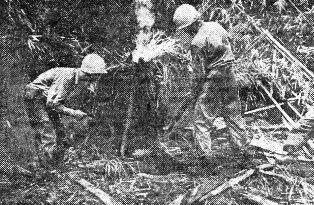
|
Before night fell, I had an opportunity to chat with USO Camp Show 99, which is another way of saying I chewed the verbal fat with Gene Emerald, Basil Fomeen, Joe Tershay and Jack Cavanaugh. These four veteran troupers, fellows who have all seen their 40th birthdays, shipped from Shangri-La on Aug. 25, 1943, and since then have given better than 600 performances in Italy, Africa, the Persian Gulf Command and CBI. Already, they have given several shows for troops in Myitkyina; now, while finishing their schedule in and around town, they are hopefully awaiting permission to entertain in China. Sudden thought: This is the type of troupe that you don't appreciate until you see it perform. Then you figuratively kick yourself in the seat of the pants for not recognizing that it would be entertaining, despite the fact there aren't any big-name stars. USO Camp Show 99 demands no complicated props, no Special Service officer to accompany it, there are no prima donnas to pamper, the four troupers catch transportation where and when they can and take care of their own personal needs.
Just about sack time, I heard the sound of music and decided to investigate. It drifted from down the road a piece, where a light burned dimly inside a canvas tent. A phonograph was playing something solid by Benny Goodman, and blonde, stocky T/5 Charles Purnell, of Oklahoma City, glanced up from the tattered newspaper he was reading when I entered. Purnell is a member of the Special Service detachment which reached Myitkyina by plane 10 days after resistance in the town officially collapsed. The eager beaver type, he was anxious to tell me about the unit, which numbers 32 men, including a 12-piece dance band and a seven-man stage show.
"We're fixing up the place next to this tent into a club hall," he said, indicating to a temple a little the worse for wear.
According to Purcell, movies were shown in Myitkyina two days after the Japs were driven across the river, and now they are being exhibited every other night. The latest on the program, he announced, was Cabin in the Sky.
He escorted me to the Special Service warehouse, stocked with radio-phonograph combinations, cigarettes, candy, magazines and books, shortly to be distributed to the various units.
Coffee and donuts, I learned, would be served in the club-room as soon as the doughnut-making machine arrived from the Mogaung Valley.
The entertainment schedule called for Ann Sheridan and party in a few days.
Suddenly, I laughed like hell as the thought struck me that G.I.'s at the front might shortly be referring to troops in the town as "those (censored) Myitkyina Desk Commandos."
Sleep was hard to come by inside my tent, under the mosquito bar. Though night had fallen, it was still hot and sticky. But then sullen rain clouds moved in from the south. Rain pattered on the canvas and a cool breeze stirred. I grew drowsy. Walawbum . . Shadazup . . Mogaung . . Myitkyina . . next stop, Bhamo, and someday Uncle Joe will be in Rangoon. I fell asleep.
Army-Trained Canines Flush Japs In Burma
Roundup Staff Article
Here's news: Dog bites man.
Having read all the journalistic text books, the Roundup realizes this is a sharp contradiction of the time-hallowed axiom. But, then, the editor who made the famous observation about man biting dog didn't know that one day there would be such a unit as the CBI War Dog Detachment.
Slim, boyish, 26-year-old Lt. Charles Fallon this week told the Roundup of the functioning of the canine G.I.'s in Northern Burma against the Japanese.
Leader of the unit, largest of its kind in action for the U.S. Army in this war. Fallon was armed with superlatives.
"The proof of the pudding is in the eating," declared Fallon. "Combat leaders during the North Burma campaign have unanimously lauded the dogs. And as more concrete evidence, they've asked for more."
VIVID INSTANCES
He described three vivid instances in which members of the detachment earned their special dehydrated horse meat ration and justified the long months of training devoted to them.
"A Jap, armed with a bag of hand grenades, infiltrated into an inner perimeter and, at midnight, had crawled as far as the command post. Fortunately, he stumbled into one of our dogs, chained up near the fox hole occupied by his master, T/5 Delbert V. Armstrong. So grievously did he chew up the Jap that he pulled a grenade from his bag and pulled out the pin against his own chest. The members of the command post, accustomed to night disturbances, didn't learn until morning about their miraculous escape.
ANOTHER OCCASION
"Another time, Pvt. Henry J. McMullen, Jr., led a patrol toward a fringe of woods. His dog gave indication that it contained a force of enemy in greater strength than the patrol. They dropped back and called for artillery fire. Later, it was discovered that the force of Japs, numbering 125, was only 30 yards down the trail from where the patrol turned back.
"Then there was the time a commander knew there were two Jap snipers in an area but couldn't flush them. A patrol was sent out with T/5 Rusty Miszner, whose dog alerted him in a clearing. Miszner judged the Japs were 50 yards
|
The detachment, a branch of the Quartermaster Remount Service, consists of one other officer besides Fallon - Lt. George G. Miller, Jr., of Denver, Colo., who is the third generation in a family of veterinarians and according to Fallon, "a damn fine vet."
The dog handlers are enlisted men volunteers, all of whom were aware of the dangers the duty would involve. They trained for at least a year, concluding with a concentrated "commando course," before shipping overseas. Details of the training, of course, are a closely-guarded military secret.
"It is needless to point out that the key to success in handling dogs is a genuine love for them," said the lieutenant. "Additionally, a man must have indefatigable patience, the willingness to work long hours at very routine tasks."
A dog in the Army leads a more satisfactory life than a "civilian" dog. he realizes his innate desire to lavish love and affection upon one particular man. He feels that this person is his man, belongs to him alone. As a matter of fact, he is extremely jealous, in civilian life, you spend only a couple of hours daily with your pet. The enlisted men of the detachment spend 16 to 24 hours a day with their dogs and accord them more meticulous care than a blue ribbon winner.
The affection of dog for man is reciprocated to the fullest, related Fallon. His own life is the last thing a handler would lose before he would lose his dog, who has safeguarded him on many an occasion. Indeed, the lieutenant has seen strong men, proud of their manliness, break down and cry when they thought they would lose their dogs.
All the animals - German Shepherds, shepherd crosses, collies and Dobermans - are donations to Dogs For Defense, Inc., a patriotic civilian organization. To qualify, they must be 20 inches tall at the shoulders, more than 50 pounds in weight and from one to five years old. Oddly enough, the mongrels have proven as well disciplined and alert as the pure breds. After the war, the dogs will revert to their original owners, unless they agree to sign them over to their handlers. "And," said Fallon, "I know that most of the men will want their animals."
Fallon, an Artillery officer, came off maneuvers in the United States and was informed he was one of the Ground Force officers of his division chosen to take the course at, of all places, cat Island, Miss. Upon its completion, he was to act as an advisor on war dogs to his division commander, "in addition to my other duties." But he wound up instead, as a detachment commander. He hasn't regretted the move, describing his enlisted men as "the finest type of soldier with whom I've ever served."
Dogs have served in battle for time immemorial. With Julius Caesar and Hannibal and other historical warriors. The U.S. Marine Corps used them at Bougainville and the Army more sparingly in the Southwest Pacific. Fallon's unit is the largest ever shipped overseas, and in their primary duties as points on patrols and as sentries the dogs have proven their worth a hundred times over.
Yank Medicos Laud Chinese For Courage
By JACK GUINN United Press Correspondent
NORTHERN BURMA - In the midst of the sweltering heat and thick, foul-smelling mud of Northern Burma, an American medical battalion is caring for Gen. Joseph W. Stilwell's Chinese soldiers and wondering whether the battalion will ever find use in the tangled jungle for the mountain-troop training it received in the snow and ice at Camp Hale, Colo.
"We didn't bring our skis," the battalion commander, Lt. Col. Adolph Faller, of Chicago, said, "but we could sure use them down some of these slick hills."
USE BAMBOO
They have built hospitals and hospital equipment from the Burma bamboo, they have performed amputations with cross-cut saws and long Burmese knives, staying with their patients on the operating tables through Japanese artillery barrages and the accidental but nevertheless deadly barrage of rice bags falling from supply planes.
Many of the men here have just returned to battalion headquarters after serving as long as six months as flank medical units with the soldiers who fought the Japs down through the Mogaung Valley. They brought back stories of their own hardships in the jungle - which they tell now with a laugh - and praise for the Chinese as patients.
60-MILE TRIP
The officers told - with amazement still in their voices - how Chinese litter bearers carried sick and wounded men 60 miles down slippery mud trails from an elevation of 4,600 feet to 733 feet. The Chinese litter bearers move at a slow trot, a gait which keeps the patients from swaying too much on the makeshift stretcher, constructed from bamboo.
The patients on the litters, some badly wounded, suffer in silence, comforted only by their peculiar philosophy about pain.
Among those on the trip were: Cpls. Michael Norcia, E. B. White, Jr., E. V. Feld and Andrew Setz; T/5's John Princiotta and Dominick M. Pizzuti; and Pvt. Eugene Smith.
Current Restrictions To Limit CBI Christmas Presents
Roundup Staff Article
It was revealed this week in the office of Lt. Col. E. E. White, Theater Postal officer, that existing restrictions make it impossible to relax present limitations on sending home parcels during the Christmas season.
Current restrictions of one 10-pound package per man monthly, combined length and girth not to exceed 100 inches, will remain in force, it was said, though it is hoped that Christmas gifts sent to the States from CBI will go by air, as has recently been the case.
A deadline of Oct. 15 for mailing gifts home was suggested, to allow for customs or other delays, although those sent much later will arrive in time if carried by air.
Many CBI troops will beat the mailing bugaboo, this year as last, by resorting to the Army Exchange Service. In those stations where continuous PX service operates, colored catalogues of available gifts will be on display. The soldier simply pays his money and takes his choice, giving the name of the addressee, and the gift chosen is packaged and delivered at Christmastime in the States.
Deadline for filling AES orders, however, is Sept. 19, because of the tremendous volume of gift business which must be handled by the organization, suffering from the usual wartime help shortages. Flowers, perfume, costume jewelry, cosmetics, shaving sets, the inevitable neckties, books, magazine subscriptions and candy are some of the items offered.
14th Air Force B-24's Sink Jap Ships In Night Attack
Roundup Staff Article
Millions of yen worth of Japanese airplanes, shipping and trucks were destroyed by the 14th Air Force in a week of savage aerial assaults on the holdings of Nippon in China.
B-24's which roared over Takao harbor on Formosa Island
|
DESTROY TRUCKS
Earlier in the week, fighter-escorted B-24's staged a vicious 30-minute air battle with 25 to 30 Jap fighters which intercepted them five minutes from their target, the Yochow railroad yards. Sixteen Nips were claimed as destroyed, with four more probables and many damaged. One B-24 was lost.
B-25's and fighters which swept the road from Yochow to Changsha to Hengyang reaped an unusually large toll of the fat Jap motor convoys, piling up a total of 776 trucks destroyed or damaged by strafing or low-level bomb attacks.
Enemy shipping on the Yangtze and Siang Rivers, in the battle area, was also heavily hit. B-25's destroyed two 1,200-ton steamers and damaged a smaller one between Yochow and Kiukiang on one sweep. Chinese-American Composite Wing fighters which sank an 80-foot boat between Hankow and Sinti were intercepted by 12 to 15 Zeros, of which eight were shot down and two damaged.
AIRDROMES BOMBED
Two 300-foot, four 250-foot riverboats, a 200-foot gunboat and many other craft were damaged in river raids.
The Jap-held airfield at Hengyang was attacked frequently during the week, while thrusts were made at Pailuchi, Hankow, Siangtan and Linsiang airdromes. Tien Ho and White Cloud fields at Canton were bombed five times by B-25's, which also hit twice at Kaitak air base, southeast of the city.
From the week's operations, 13 planes of the 14th AF are missing, but Jap air losses totaled 34 destroyed, seven probably destroyed and 31 damaged.
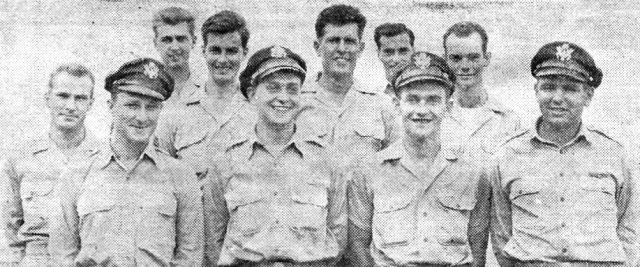 Meet the 10 members of the 14th Air Force B-24 crew who recently sank a 550-foot Jap cruiser, 100 miles east of
Hong Kong. The bombardier, Lt. John D. Shytle, Jr., has 51,000 tons of Nip shipping to his credit on six missions.
Front row, left to right: Lts. Lee O. Cunningham, navigator; William R. McCaffery, Jr., co-pilot; Shytle; and Jay E.
LeVan, pilot. Second row: Sgts. Bruce L. Ludwig, nose gunner, and Lawrence F. Bowar, gunner; and T/Sgts. Charles W.
Hemsley, engineer, and Harry A. Niess, radioman. Third row: T/Sgt. Edward N.
Odom, radioman; Sgt. Norman A. Lareau,
tail gunner. S/Sgt. Thomas J. Murphy, radioman, was not present when the picture was taken.
Meet the 10 members of the 14th Air Force B-24 crew who recently sank a 550-foot Jap cruiser, 100 miles east of
Hong Kong. The bombardier, Lt. John D. Shytle, Jr., has 51,000 tons of Nip shipping to his credit on six missions.
Front row, left to right: Lts. Lee O. Cunningham, navigator; William R. McCaffery, Jr., co-pilot; Shytle; and Jay E.
LeVan, pilot. Second row: Sgts. Bruce L. Ludwig, nose gunner, and Lawrence F. Bowar, gunner; and T/Sgts. Charles W.
Hemsley, engineer, and Harry A. Niess, radioman. Third row: T/Sgt. Edward N.
Odom, radioman; Sgt. Norman A. Lareau,
tail gunner. S/Sgt. Thomas J. Murphy, radioman, was not present when the picture was taken.
|
Crippled B-25 Knocks Down Three Zeros
BURMA - A B-25 from the 10th U.S. Air Force of the Third Tactical Air Force, recently shot down three Jap Zeros after a running fight in which the bomber flew with one motor out and the left wing tank burning.
The pilot, Lt. Daniel L. Meredith, and the co-pilot, Lt. Walter F. Keating, finally made a crash landing in a swamp after flying for 60 miles at tree-top level.
The flight of B-25's was jumped by 12 Japs, of which five were destroyed by the defending gunners. Describing the combat, Keating says "It was a hell of a scrap, while it lasted. Four of the Zeros attacked us from head-on, four from astern and four from above and below. There were so many attacks on us at one time that we just kept ffsiring at everything in every corner of the sky with everything we had.
"Our undercarriage legs were shot up, flaps down and left rudder control smashed. When we broke contact we went down to 50 feet and limped along at 130 miles per hour looking for a place to land. We finally found a swamp and ditched the ship, which helped to put out the fire."
LETTER TO THE EDITOR
EDITORIAL IN SEAC LAUDS CO-OPERATION
The Roundup's hard-hitting British contemporary, SEAC, recently published the following letter, written by Sgt. K. N. Marwood, RAMC, Field Ambulance. It is an observation on an article on Anglo-American co-operation within Eastern Air Command which appeared in Editor Frank Owen's column, Good Morning. - The Editor.
Congratulations on your editorial on Anglo-U.S. co-operation. It is time some effort was made to combat adverse propaganda about the Americans which seems to be circulated more at home and in the back areas than in the forward zones.
We have had several Americans working with us right through this campaign and my own view is that you couldn't hope to meet a finer crowd of chaps. They are more sociable than the average Briton.
As far as I can see, the main objection of many people to the Americans is that they "talk big."
It's about time that some people realized just how much we owe to the Americans in this theater of operations alone; they seem to have a genius for building and maintaining at top pressure efficient lines of communication against the most difficult odds.
It is also about time some other people started to study the interest the U.S. Government takes in the welfare and pay of its troops.
New Flying Society
'KNIGHTS WITH 1,000 COMBAT HOURS'
ADVANCED 10th AIR FORCE BASE IN INDIA - Formation of an exclusive flying society has been announced with the organization of the "Knights with 1,000 Combat Flying Hours."
The club is a creation of the 2nd Troop Carrier Squadron of the 10th Air Force, EAC, an outfit famed throughout the CBI Theater for its epic job of flying The Hump and dropping food and supplies to units in the Burma jungles.
Charter members of the new society include Lts. Gordon J. Andrews, Robert W. Buechler and Marvin D. Brady; and T/5's Lawrence E. Abare, John Budrick, John C. Martin, and Archie Kuhn. The officers are all pilots and the enlisted men "food kickers."
'OLD GUARD'
Second Troop is the "old guard" tactical outfit of the 10th Air Force. To its pilots and crews went the assignment of flying The Hump in 1943 when that route was the only hope into China after the close of the Burma Road. Hazards were great and many. Jap planes and ugly weather made the going rough, but Second Troop kept its props turning and the other day received formal recognition from the War Department in the form of a unit citation.
CBI PIONEERS
When Gen. Joseph W. Stilwell's troops moved into Burma, this squadron pioneered food dropping. Pin points in the heavy foliage were the targets for the pilots and their "kickers," and few parachutes failed to hit the mark in supplying American, Chinese and other Allied forces.
TRICKY FLYING
The "Knights with 1,000 Combat Flying Hours" never had an easy time. The food dropping missions called for low altitude flying. Many of the planes came back with bits of trees in their fuselages. When the weather was good and the peaks had to be flown, Zeros were a threat and some of the planes never came back. On other occasions, mechanics discovered bullet holes from small arms fire from Jap ground troops.
Andrews, 22, was the first man in 2nd Troop to hit the jackpot of 1,000 hours last March. He had been a pilot since August, 1942.
First of the enlisted men to join the select circle was 25-year-old Budrick. He came to the CBI in January, 1943, with a truck regiment designed to carry freight over the Ledo Road. That was too slow, so he volunteered for the "kicking" assignment and since then a large measure of his time has been spent over his original route, but mostly at 100-foot altitude.
EAC Aircraft Support Drive In North Burma
Airmen of Maj. Gen. George E. Stratemeyer's Eastern Air Command this week hammered at North Burma targets to back the attack of British and Chinese-American troops pushing south from Mogaung and Myitkyina.
Effective support was furnished to 36th Division units advancing down the Myitkyina-Mandalay railroad, between newly-captured Pinbaw and Hopin. B-25's of Maj. Gen. Howard Davidson's 10th Air Force knocked out a bridge at Bhamo, destroyed large buildings at Indaw and dropped a heavy tonnage of bombs on Katha. P-47's scored two direct bomb hits on a large building at Bhamo.
RAF Liberators of the Strategic Air Force flew a spectacular mission against the vital Moulmein-Bangkok railroad, the overland supply route by which the Japs hope to avoid the now-risky sea lanes.
Many direct hits were seen along an eight-mile stretch of the line, with landslides caused at several places and one section of track 200 yards long destroyed.
On the 14th Army front, Mawlaik, on the Chindwin River, was heavily dive-bombed, as Spitfires and Hurricanes of the Tactical Air Force continued to harass enemy troops retreating down the river and along the Tiddim Road.
Bad weather hampered operations late in the week, but long-range fighter-bombers kept up daily assaults on bridges, pipelines, tracks and railroad stock in central Burma.
10 INCHES OF RAIN LOGGED - AT 10TH'S HEADQUARTERS
|
HQS., 10TH AIR FORCE - A local institution called the monsoon slid into high gear here recently, logging up 10 inches of rain (official Army weather records) in just nine hours, and left all the headquarters personnel pontooning to work and back.
Water a foot deep flooded the area, with the company street in tent city looking like the Grand Canal of Venice. The boys hung up their shoes on high nails, rolled their trousers up, and waded to duty.
It was "business as usual" in the various offices, and no harsh words from the boss if you put your feet on the desk. In the tents and basha housing the troops, they ignored the 10 inches of standing water beneath the old sack, forgot about their wet nets, and almost literally floated off to sleep.
Assam highlights of meals and mail continued under difficulty, and the boys ground out the work as ever, despite minnows in their mimeograph paper.
Amphibious warfare - without Higgins boats.
Signal Corps Group Bridges Irrawaddy
By Pvt. JOHN R. McDOWELL Roundup Field Correspondent
MYITKYINA - I've just spent a day watching 11 Signal Corps men and two Engineer light pontoon veterans complete the biggest wire-stringing job ever tackled in the CBI Theater - putting a line across the Irrawaddy River at Myitkyina.
The job, I learned the night before, was to string a wire from a 150-foot steel tower on the Myitkyina bank of the Irrawaddy to a similar tower on the far shore - a distance of three-fourths of a mile. Eventually, a number of circuits would be extended across the river, but the first line was the tough nut to crack.
ON JOB EARLY
The men, under the direction of S/Sgt. Clarence Lucas, were on the job early. They strung wire nearly a mile down the river bank, then carried it across to the far shore in an assault boat piloted by Pfc. Jack Alfieri of an Engineer pontoon company.
The wire, most of which was submerged in the Irrawaddy, was connected to the tower on the far side, but the current in the broad river, estimated at 15 miles per hour, snapped the wire before it could be spliced and pulled out of the water.
The men worked all morning. Time after time they cruised downstream and disengaged the line which drifted with the current and became entangled in submerged debris. Time after time, men swam hundreds of feet to the boat through swift current with the loose end of the line tied around their waists. And each time as they attempted to splice the two lines, the strain of the current snapped the wire.
20 ATTEMPTS
By mid-afternoon, 20 attempts to span the stream had failed. In desperation, Lucas had his men string the line through the Myitkyina tower and extend it on to another pole a quarter of a mile away. Then the new line was rushed across the river in the boat, spliced to the other line, which had been extended from the tower on the far shore to the water's edge. The splice made, a crew of men at the auxiliary pole, a mile and a quarter away, pulled out the slack through a block and tackle arrangement, and the wire was high in the air. Communications had bridged the Irrawaddy.
NIPPON COLUMNS DRIVE AT KWEILIN
CHUNGKING - (ANS) - Chinese spokesmen announced this week that four columns of Japanese had pushed westward from Hengyang in Hunan Province in an offensive directed at Kweilin, with one column within 35 miles of the forward U.S. airbase at Lingling.
The Chinese said heavy fighting was taking place near Changning and Shaoyang, west and southwest of Hengyang respectively. The Chinese claim to have cut the Canton-Hankow Railroad in three places, severing Japanese communications along this line.
Pilot Discovers Air Companions Aren't Friends
ADVANCED BURMA FIGHTER BASE - Capt. Hank Pashco accepted the company of what he thought to be four other American planes in the Burma skies recently.
But a closer look told Pashco his aerial companions were Japs, who evidently hadn't taken a close look at him either.
Quickly, over his surprise, Pashco seized advantage of his golden opportunity and opened fire. He promptly shot down the last plane in the formation, then attacked the leading ship which he claims as a probable.
The two remaining Nip craft attacked him and were joined by three others who pulled into the melee from behind a cloud bank. Things were getting too hot, so Pashco decided to get the hell out of there.
Inspection of Pashco's plane at the home base showed 10 dents in the armor plate where enemy bullets had struck.
Pashco, with over 170 combat missions, is a member of "Habecker's Hive" fighter squadron. He holds the Air Medal and Distinguished Flying Cross with two Oak Leaf Clusters for each.
A SMACK IN THE EYE
UNIQUE ACCIDENT HAPPENS IN B-25 FLIGHT
BURMA - When Lt. B. F. Watt, EAC B-25 pilot of the "Earthquakers" squadron, loosed his bombs during a recent mission, he not only gave the Japs a figurative smack in the eye, but he also gave a literal one to Lt. Charles Lord, navigator-bomber of the Mitchell following him.
Lord's aircraft flew straight into a metal strip two feet long and four inches wide used to secure bombs in pairs. Normally, it comes apart as the bombs drop. This time the strip shattered the plexiglas window of the navigator's compartment in the nose of the second plane.
Lord was showered with plexiglas splinters which left his face looking as though he'd tried to shave with a broken razor. "There was more blood than damage," he confessed, "but I wouldn't fancy a repeat performance."
|
ADVANCED BOMBER BASE IN INDIA - The recent success of the Allied troops in driving the Japanese from Imphal was due in part to ammunition flown in by the bomber planes of a USAAF B-25 squadron, the headquarters of Maj. gen. Howard C. Davidson, Commanding General of the 10th Air Force, EAC, has announced.
Pilots flew hundreds of sorties to deliver the tons of ammunition and found new problems to meet in their temporary transport missions which were vastly different than those encountered in their usual work, that of bombing. Ordinarily, a B-25 lands with a light load because the bombs have been dropped over the target. However, transport flying meant landing with a heavy load and making new calculations in operation of the plane.
The flights were made in some of the worst monsoon weather and in the face of attacks by Jap fighter planes. In fact, the loss of bombers, while numbering only a few during the transport operations, was greater per 100 sorties than any previous 100 bombing missions flown over a year's time.
When Chaplain Goes - Roundup Hears Woes
The Roundup regularly gets its editorial ear bent by letters full of woe from the long weeds, but one job this week was the cincher. M/Sgt. Harold Bergner at APO 689 relaxed, he said, a 35-year-old policy of not writing "letters to the editor" and let us have it with an eight-page beauty.
At the end of the whole recital was this P.S.: "I forgot to mention that the Chaplain announced at last Sunday's services that he would not be with us in the future, so you are the only ones left to tell my troubles to."
Roundup has transmitted his troubles to the proper department.
|
Phillips, a member of an Engineer pontoon company now operating assault boats on the Irrawaddy, had just returned after taking a party of Chinese Infantry 20 miles down the river behind Jap lines.
DODGED PATROLS
"Kind of hot down there," he said. "Ran into two Jap patrols who tried to pick us off from shore. Lead flying everywhere. But I hugged the shadows on the far shore and gave old Nell the gun and we got out of range pronto."
Phillips outfit, after building and maintaining pontoon bridges on the Ledo Road for the past year, has attained a reputation as Jap-hunters since arriving in Myitkyina six weeks ago.
KILLED JAPS
While maintaining the railroad line between Myitkyina and Mogaung, they killed two Japs and captured one who tried to raid their camp. And, after they moved to their present camp on the Irrawaddy, where they are engaged in ferrying troops and supplies down the river, they killed 85 Japs and took 30 prisoners when a large party of Nips attempted to escape downstream on rafts.
"It was like shooting clay pigeons at Coney Island," Phillips said.
ROTATION? NOT FOR PVT. PORTER
By Sgt. PHIL BERSHAD Roundup Correspondent in China
CHINA - gather round, ye sweating CBI rotationalists, and listen to the tale of a fellow G.I., who isn't anxious to rotate anywhere. He's at home right here.
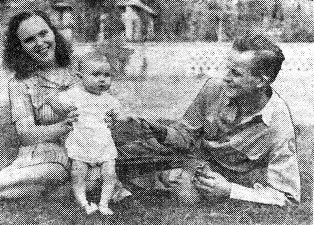
He's Right At Home In China |
The name is Pvt. Bob Porter, formerly of Oberlin, O., but more recently a resident of China. Bob has two very good reasons for wanting to stay right where he is: His charming wife, Virginia, and their 10-month-old daughter are here with him.
Porter got the wanderlust shortly after graduating from Oberlin College and headed for the Orient, where he found a former co-ed classmate teaching English in a Chinese middle school. They resumed their friendship and, some months later, were married by an American missionary friend.
Porter has been in China for almost five years now, working first for the Chinese Central Government and later for the American Engineers as a civilian. He was with the Engineers, helping construct the recently-completed super-airbases, when his Ohio draft board notified him to report to the nearest Army base for induction.
After Maj. Alfred Schauder, Base Adjutant, had sworn Porter into the Army, the problem of clothing him arose. The Service Group of which he was now a member was newly arrived from another theater of operations and its Quartermaster equipment hadn't followed it over The Hump. His new G.I. buddies quickly solved that, however, by contributing shirts, socks, trousers, underwear and all the rest of the necessary clothing. The next problem took a little longer. Porter didn't have an Army serial number. He found out how very necessary this was when he attempted to get paid and was told it couldn't be done until he received his ASN. He really sweated out the next three months, until the War Department sent him the dollar-laden digits.
Bob is now working in the Base station hospital, taking the Army in his stride.
The additional money for overseas duty isn't hard to take, since he had been working overseas for five years without getting extra money for it. And, of course, his wife is always there to comfort him after a rough day with the top sergeant.
RECORD FOR BREVITY
BURMA - Lt. Robert N. Gale climbed into his fighter-bomber plane, took off, pulled up his wheels, dropped his bombs, destroyed a bridge at the edge of a Jap stronghold and returned to his field.
Elapsed time: slightly under six minutes - claimed as a record for brevity.
That's how close the "White Nose" boys of the Burma Banshees were to the Japs in Burma, less than 2,000 yards or a third of a mile from enemy entrenchments for some time.
Planes of the "front line" 10th Air Force outfit of the Eastern Air Command took off regularly and seldom got out of sight of their home field, despite the fact it was vulnerable to artillery fire and practically within sight of the Japanese. Thus members of the ground crew had an almost daily (and unique) opportunity of watching the planes they serviced and loaded with bombs and ammunition diving down in attack.
Capt. Owen R. Allred holds the record for missions flown in a single day: Six.
Chief squadron casualty from Jap shellings was the field range, parked under a beautiful blue parachute. Shrapnel pierced the range's gas tank, and forced Mess Sergeant Ralph A. Carnley to postpone the next meal until he got the stove going again - using an oxygen tank from a salvaged P-40.
Thanksgiving Menus 'All Out'
CBI gourmets can eye this week the War Department announcement that Thanksgiving menus as announced for Army messes in the States "will be followed as closely as possible" for overseas personnel.
The Army came out with the following list that will decorate G.I. messes Thanksgiving:
"Grapefruit juice, roast turkey, giblet sauce, dressing, mashed potatoes, string beans, corn, cranberry sauce, celery, olives, pickles, hot rolls, butter, pumpkin pie, apples, tangerines, candy, nuts and coffee."
The War Food Administration announced that the Armed Forces would have priority on turkey, but that there would be enough for military and civilian alike. The Army has already taken over more than 1,000,000 pounds of turkey for distribution.
MUSIC 'MIDST ASSAM TEA PATCHES FOR G.I.'S
Two Guitars Made Up From Odds and Ends at 10th Air Force Base
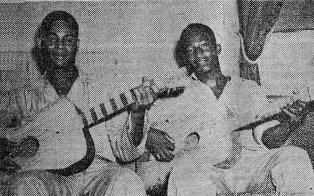
No Barrier Too Stout For Ingenuity |
TENTH AIR FORCE BASE, INDIA - Entertainment is hard to come by among the tea patches of Assam, but American ingenuity frequently solves the problem.
A Negro ack-ack unit attached to Maj. Gen. Howard C. Davidson's 10th Air Force was faced with the obvious alternative of amusing itself or else not being amused.
More than anything else, the G.I.'s decided, they wanted music.
So a couple of the lads went on a reconnaissance. But they could neither beg, borrow nor steal instruments.
To every problem, however, there is a solution to a determined American G.I. They set about making their own instruments.
The result was that Cpl. Lee O. Jamerson, Buena Vista, Ga., and Pfc. Charles Bass, Bunnlevel, N.C., manufactured a pair of guitars, which, if not elaborate, at least gave the men the music they sought.
The box part was whittled out of C-ration crates. The tail pieces were salvaged from the fuselage of a damaged airplane. The pegs were cut from a piece of oak, while the frets came from aluminum off an airplane.
At three times Stateside cost, the strings were purchased locally.
Now the unit has melody. The guitars brought out some fine voices among the battery's personnel and a good chorus was formed.
Now the entire crew is in great demand throughout Assam.
|
A LESSON IN SECURITY
Security, for the most part the simple business of not shooting off the mouth, is generally a pretty hush-hush affair. It's seldom that the Roundup is able to quote chapter and verse of security violation, generally kept secret until after a war is all over. This is one of the exceptional cases, and we pass it along to you for guidance.
During the Allied advance in Italy, a large part of the Intelligence files of the German 14th Army were captured, a set of documents which provided a rarely obtainable insight into the methods of enemy intelligence and the degree of success obtained by our own security measures.
Here's what they found, as reported in a military publication hitherto classified as SECRET:
The most significant item was a map, showing the Allied order of battle as known by the enemy the day after our attack began. The Germans had, on the whole, a fairly accurate knowledge of the disposition of the troops which had been for some time in the front line. They had been able correctly to place two U.S. and two British divisions. Corps sectors were shown correctly, although the headquarters were wrongly located by a matter of a few miles.
The information in Nazi hands was by no means complete nor entirely accurate. The Germans underestimated our strength in the area of our main attack by seven divisions. He credited us with having much larger reserve in the back areas and, in view of this fact, he appreciated that our frontal attack was only diversion and that we intended to carry out another landing in his rear. Our attack was made in much greater strength than he expected.
All German divisions in reserve were grouped around the Anzio Beachhead or strung out along the western coats and, by the time the Nazi had decided his fears of a landing were groundless, these reserves were so slow in reaching the scene of battle that they were drawn in and destroyed piecemeal.
This is a most impressive example of the advantages to be gained through observance of security measures. The situation traced from subsequent dates shows a gradual correction of the enemy's original false impression. By May 23, most un its on the southern front had been identified in roughly their correct positions and, in order to reduce his original underestimate, the enemy had produced certain fictitious formations.
It is to be expected that in the course of a battle the enemy will gradually find out what units are opposing him by taking prisoners, but it is unfortunately true that Allied prisoners have been guilty of giving away a great deal of information.
Captured interrogation reports gave the names of 23 officers and men who were taken prisoner by a German parachute division. From questions, it appears that the Germans were able to gain much information on the tactical situation and even on such subjects as Allied convoys. The prisoners needlessly gave away the strength and organization of their own units, the names of their officers, the previous histories and future intentions of their units and the password of the day.
What about CBI? Get a load of this. Allied counter-intelligence men, operating against the Japanese in China and India, recently discovered that the Japanese knew the B-29's were coming out here six months before the first of the Super-Forts arrived. A captured Jap intelligence report shows that the Japs had not only performance data on the B-29, but they knew the number which were expected in CBI.
What can you do about it? Just this: Take it for granted that every stranger is an enemy agent. If he, or she, isn't he or she won't be interested in that juicy morsel of information you were about to give them, so why bother to sound off, for free? The war is tough enough without pop-offs making it tougher.
The C.B.I. Roundup is a weekly newspaper of the United States Army Forces published by and for the men in China, Burma, and India, from news and pictures supplied by staff members, soldier correspondents, the United Press, OWI and Army News Service. The Roundup is published Thursday of each week and is printed by The Statesman in New Delhi, India. Editorial matter should be sent directly to Capt. Floyd Walter, Headquarters, U.S.A.F., C.B.I., New Delhi, and should arrive not later than Sunday in order to make that week's issue. Pictures must arrive by Saturday and must be negatives or enlargements. Stories should contain full name and organization of sender.

SEPTEMBER 7, 1944
Photo of Lord Mountbatten and Maj. Scheie replaces original photo of Mountbatten alone.
Copyright © 2008 Carl Warren Weidenburner
TOP OF PAGE PRINT THIS PAGE ABOUT THIS PAGE SEND COMMENTS
PREVIOUS ISSUE CLOSE THIS WINDOW NEXT ISSUE
 When Pvt. Marion Hargrove, now Sergeant, was learning "squads right" at Fort Bragg, N.C., little did he dream that
the yeasty book he was writing would be produced as a movie and lovely Donna Reed would perform in it. Hargrove
represented Yank magazine in CBI-land for a time, but returned to Shangri-La some months back.
When Pvt. Marion Hargrove, now Sergeant, was learning "squads right" at Fort Bragg, N.C., little did he dream that
the yeasty book he was writing would be produced as a movie and lovely Donna Reed would perform in it. Hargrove
represented Yank magazine in CBI-land for a time, but returned to Shangri-La some months back.
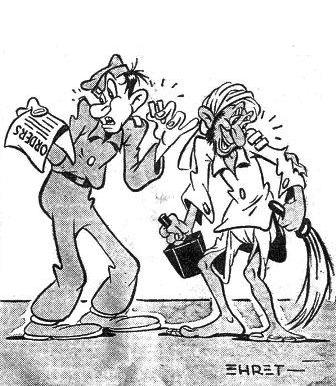 "PERSONALLY, I THINK SOME MISTAKE HAS BEEN MADE."
"PERSONALLY, I THINK SOME MISTAKE HAS BEEN MADE."
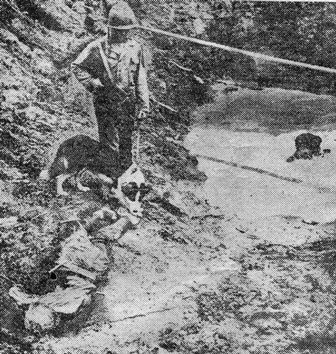 In this Army Signal Corps photo, Pvt. Joseph M. Self, of Greely, Colo., and his War Dog pass a Jap body sprawled
in a bomb crater while on patrol searching out snipers in the Myitkyina area. Officers in command of the operation
praised the work of the animals.
In this Army Signal Corps photo, Pvt. Joseph M. Self, of Greely, Colo., and his War Dog pass a Jap body sprawled
in a bomb crater while on patrol searching out snipers in the Myitkyina area. Officers in command of the operation
praised the work of the animals.
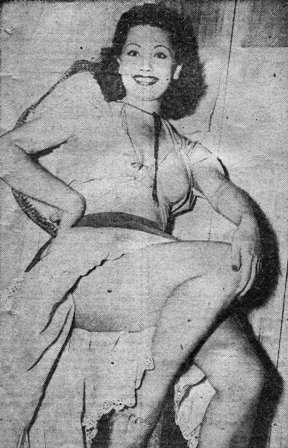 14th Air Force sent the Roundup the above eye-filler and informed us that G.I.'s on the east side of the
Hump had unanimously selected Mary Landa as their "Cheesecake Girl of the Week."
14th Air Force sent the Roundup the above eye-filler and informed us that G.I.'s on the east side of the
Hump had unanimously selected Mary Landa as their "Cheesecake Girl of the Week."

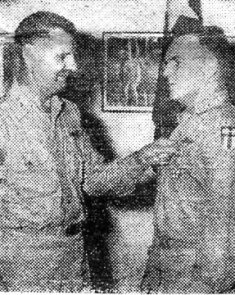 Stars were rampant recently in a room at EAC Headquarters, where EACissimo Maj. Gen. George E. Stratemeyer, left,
presented the Legion of Merit to Maj. Gen. Thomas J. Hanley, Jr., commanding the CBI Air Service Command.
Stars were rampant recently in a room at EAC Headquarters, where EACissimo Maj. Gen. George E. Stratemeyer, left,
presented the Legion of Merit to Maj. Gen. Thomas J. Hanley, Jr., commanding the CBI Air Service Command.
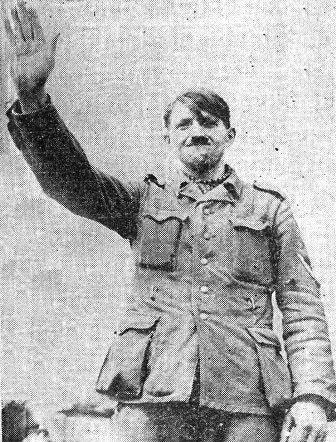 This Nazi prisoner pulled a take off on Der Fuehrer for the amusement of his American captors. The "Nazi salute"
order is said to have caused a decline of discipline in the German Army.
This Nazi prisoner pulled a take off on Der Fuehrer for the amusement of his American captors. The "Nazi salute"
order is said to have caused a decline of discipline in the German Army.